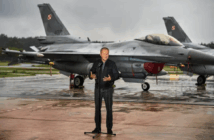Welcome to the CavasShips Podcast with Christopher P. Cavas and Chris Servello…a weekly podcast looking at naval and maritime events and issues of the day – in the US, across the seas and around the world.
This week…the House and Senate armed services committees have approved big increases in the number of new ships to buy and in the Pentagon’s overall budget. But where’s the money? Will the appropriations committees agree? And – hurricanes, floods and rising waters. We take a look at how hurricanes and climate change can hit the Navy in its shipbuilding breadbasket – the Gulf Coast.
In this Week’s Squawk Chris Servello comments on climate. change.
Please send us feedback by DM’ing @CavsShips or @CSSProvision or you can email chriscavas@gmail.com or cservello@defaeroreport.com .
This Week’s Naval Round Up:
As we record this podcast five people remain missing after the crash on August 31 of an MH-60 Sierra helicopter from Helicopter Sea Combat Squadron 8 while operating aboard the aircraft carrier ABRAHAM LINCOLN. The Navy has released few details, but the incident took place while the helo was operating on the carrier’s flight deck. One helicopter crew member was rescued shortly after the helo went into the sea, and five LINCOLN sailors on the ship’s flight deck were injured in the accident. The LINCOLN was engaged in training exercises about 60 miles off the Southern California coast.
The British HMS QUEEN ELIZABETH Carrier Strike Group 21 continued operating in the western Pacific as August drew to a close. Aircraft from QUEEN LIZ flew on August 26 with those from Carrier Air Wing Two flying from the carrier CARL VINSON. The aircraft included F-35C Joint Strike Fighters flying from VINSON and F-35Bs from the QUEEN ELIZABETH. On August 28 the VINSON put in to Yokosuka, Japan for a port visit.
The US Coast Guard cutter MUNRO also continued a busy western Pacific deployment. After operating with the Japanese Coast Guard and making a Taiwan Strait transit, the California-based cutter conducted exercises with Filipino Coast Guard and Bureau of Fisheries units before putting in to Subic Bay on August 31.
On August 31 the small Russian corvette SOVETSK launched a Kalibr-NK cruise missile from the White Sea and hit a target more than a thousand kilometers away near Arkhangelsk. The exercise was another demonstration of how very small Russian warships – in this case a 220-foot-long, 860-ton ship — can use the Kalibr missile to hit targets from distances up to and exceeding 1,000 miles. The SOVETSK is a member of the Project 22800 Karakurt class now in series production for the Russian Navy..
The LYNDON B JOHNSON, third and last ship of the DDG1000 Zumwalt-class of large stealth destroyers, completed initial sea trials Sept. 2 and returned to the General Dynamics Bath Iron Works shipyard in Maine. While the hull, mechanical and engineering systems were tested the ship is still a long way from being complete, and full combat system installation and activation remains to be done before a scheduled delivery to the Navy in 2023. The previous two ships of the class, ZUMWALT and MICHAEL MONSOOR, are based in San Diego, where LYNDON JOHNSON will join them upon entering service.
On Sept. 2 the House Armed Services Committee approved its fiscal 2022 authorization bill. By an overwhelming 57 to 2 vote the HASC added five ships to the Navy’s request for a total of 13 ships – an additional two destroyers, an amphibious assault ship, another expeditionary fast transport and another fleet oiler. The HASC also approved additional $24 billion to the overall topline for the Defense Department, similar to an additional $25 billion added earlier by the Senate Armed Services Committee. The bills now move to the House and Senate for floor debates and votes. While there seems to be general agreement about the House and Senate policy bills, it is by no means clear what the money committees – the House and Senate Appropriations committees – will do with their markups. We’ll discuss this in more detail in a moment.
SQUAWK BOX Servello:
Building on today’s discussion about Hurricanes Katrina and Ida, as well the increasing vulnerability of our shipbuilding, maintenance and berthing facilities…its time to have a serious discussion about climate change and it’s long term effects on naval operations.
Like many issues in America today…climate change has become emotionally charged and difficult to intelligently discuss.
There are some that will run around panicked, hair on fire, saying the sky is falling…demanding immediate change in either behavior or spending without having a plan or clear way forward. I suppose that’s one approach. But what I’m suggesting is a more thoughtful way ahead that considers all of the issues and challenges associated with dealing with the climatological effects being felt and documented across the globe.
As navalists and first order thinkers, our audience is uniquely positioned to set the unnecessary emotion aside and let science and reality guide our discussions.
Simply asked…are we prepared as a naval community to deal with rising sea-levels, superstorms and melting ice in the high North? I think the simple answer is No.
Climate change presents a logistical, fiscal and force structure challenge to America’s Navy and industrial base as we consider ways to disperse shipbuilding and maintenance facilities, pay for needed pier and berthing upgrades and grow fleet capability and capacity to deal with the security challenges associated with our changing climate.
Friend of the show and naval-big-thinker Bryan McGrath says it best…more water requires more ships. I agree and would simply add it also requires more thinking on the part of the naval community.
Look for more discussion on this pod and across the Defense & Aerospace network as we help lead and share the needed discussion that must take place on this important environmental…and crucial national security issue.




